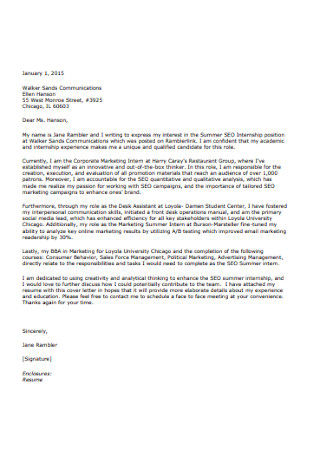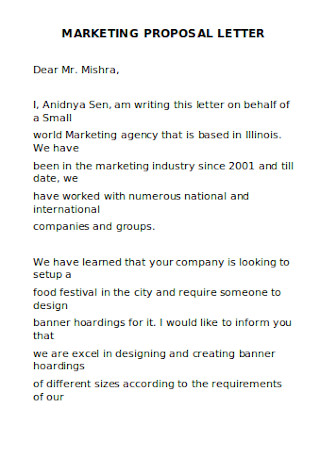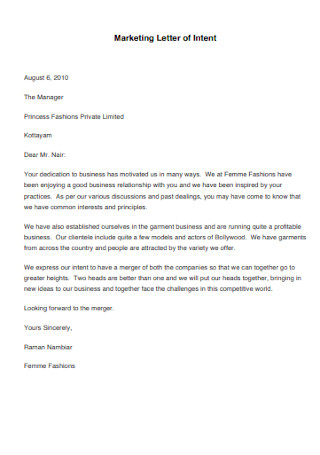20+ Sample Marketing Letters
-

Digital Marketing Letter
download now -

Final Marketing Letter
download now -

Marketing Survey Cover Letter
download now -

Sample Marketing Letter
download now -

Business Marketing Letter
download now -

Basic Marketing Letter Sample
download now -

Landlord Marketing Letter
download now -

Real Estate Marketing Letter
download now -

Simple Marketing Cover Letter
download now -

Sample Marketing Cover Letter
download now -

Commercial Marketing Letter
download now -

Customer Marketing Letter
download now -

Marketing Manager Cover Letter
download now -

Marketing Assistant Cover Letter
download now -

Marketing Assistant Applicant Letter
download now -

Sample Marketing Manager Cover Letter
download now -

Basic Marketing Cover Letter
download now -

Formal Marketing Letter
download now -

Marketing Cover Letter Sample
download now -

Marketing Proposal Letter
download now -

Standard Marketing Cover Letter
download now -

Marketing Letter of Intent
download now
“Consumers are 53% more likely to shop with a business they can message.”
“The vast majority, almost 96%, of bloggers drive traffic through social media, with 64% through SEO and 58% through email marketing.”
“In-app messages are 1.5 times more likely to be opened as emails, and 6.7 times as likely to receive a response.”
“Eighty percent of respondents indicated grammatical errors were one of the biggest email faux pas. Next on the list included: profanity, irregular fonts, capitalized subject lines, excessive punctuation, and lack of subject line, which 70% of respondents said was unacceptable”
What Are Marketing Letters?
If you are looking for a simple definition of what a marketing letter is, this would be something written by sellers for the purpose of impressing and attracting potential buyers and customers. This is intended to advertise whatever products or services that you and your company have to offer. People do not want to dive head-first into their purchases without being informed first, so a marketing letter can be expected to have immense significance to your marketing campaign. There are multiple types of marketing letters, each one different not only in terms of structure but also its specific use.
Types of Marketing Letters
It has been mentioned before that there are multiple types of marketing letters in existence. Now you can browse through an actual list of said types. Each one is tasked with a different role although its ultimate purpose remains exactly the same: to gather potential customers and increase the value of your brand or company. With that said, take a look at each marketing letter variety and see for yourself just how nuanced this tool can be.
How to Create a Marketing Letters?
As a professional marketer, it is inevitable that you will someday be required to craft your own marketing letter. Therefore, it is also important to learn how to create one in a way that will catch your potential customers’ attention, entice them, and bring them over to your store. The following guide may prove to be just what you need in order to reach the level of success you desire, so be sure to take a close look at each step as you progress. After all, the creation of a marketing letter does not have to be an overly difficult task.
Step 1: Identify Your Market
The first step that you need to take when creating your own marketing letter is to decide for whom it will be sent to. It is very important to possess a solid understanding of your own customer base. That way, you will be more aware of what type of customers are most receptive to the marketing materials that you intend to send out. There are multiple ways for you to help narrow your focus, and that includes using client lists, looking through an industry association’s database, and more.
Step 2: Make a Customized Mailing List
For those who are looking to do an outreach campaign that is intended to be a bit limited in terms of scope, then there is always the option of creating your own custom mailing list. As an example, you can include the many contacts you’ve made at a recent business exposition. Or perhaps you may have a list of recipients from the ones who signed up for your business’ newsletter or company email.
Step 3: Begin Your Message with an Introduction
Having decided on who your letter is directed to, now comes the part where you actually start writing it. Any letter that’s worth looking at will begin with a solid introduction. For best results, do not make your message sound generic or vague. Instead, opt for a more personalized tone that makes it seem like you are directly speaking to your target audience. By humanizing the approach, you can catch their attention better. The rest of the details should be generally smooth sailing from there.
Step 4: Entice with a Limited-time Offer
Although there is the choice to be straight forward with your message, it can help if you include mentions of certain offers or promos. A tactic like this is meant to further entice your customers. What better way to accomplish that than by talking about a limited-time offer that is sure to run out soon if the recipient does not act quickly. Even if they do not act, this will give them an indication of what you are capable of and they might be more receptive to future offers from you in the future.
Step 5: Invite the Recipient to an Event
In the event that you have no special product or service to offer, you can always entice your customers by inviting them to an upcoming event that is either hosted by you or sponsored by your business. The purpose of this would be to drive traffic to the event while allowing your brand to thrive via the increased awareness of your customers.
Step 6: Proofread and Edit
Now that you have finished crafting your letter, the last step before you send it would be to look over it again and make edits where they are necessary. As a business, you cannot afford to have many glaring mistakes because that would mess with your credibility.
The Do’s & Don’ts of Marketing Letters
By now you should be more knowledgeable and familiar with the intricacies of marketing letters. However, there are still a few things that you need to learn about them, namely the pitfalls that one needs to avoid at all costs and all the things that can improve your work vastly. Take a look at each of these do’s and don’ts to ensure that your marketing letter is as high quality and effective as you plan for it to be.
The Do’s
1. Do make sure that you have a crystal clear message
It would not do to create a marketing letter when you do not even know where the message is headed. Letters like that are not only difficult and confusing to create but your customers won’t find it very appealing either. No matter what you try to create, it is always advisable to have a clear message so that there won’t be any misunderstanding on anybody’s part.
2. Do make sure that the language you use is just as clear
If people cannot understand what you are writing, then your letter will not be effective. With that in mind, it is important to use language that is just as clear as the message you are trying to get across. Keep things simple and be as direct as you possibly can be.
3. Do check for any spelling and grammar errors
Put yourself in the shoes of your customers. You receive a letter and discover numerous spelling errors as well as sentences that are grammatically weak. That does not seem like something that will impress anybody. With that said, it is important that you take the time to go over your drafts and see if there are any errors for you to correct. Doing so might be a bit tedious and you will be tempted to skip it. By resisting the urge, you will further ensure the success of your marketing letter.
4. Do play it safe when using humor for the letter
Humor plays an important part in human interaction as a whole, but not everybody shares the same preferences. Whenever it is appropriate, perhaps it would be better to exclude jokes that may come off as tasteless or unrelated to whatever product or service your company is trying to market. Be very careful when it comes to jokes because the wrong ones can easily derail a marketing letter that might be otherwise well-written and high in quality.
5. To create an excellent subject line
If there’s a phrase that can sum this last “do” up, it would be “first impressions are everything”. The moment people see that they’ve received an email, one of the very first things that they would notice is the subject line. If it does not appeal to them, your letter won’t be read. Should your subject line be good yet at the same time not good enough, then your letter still won’t be read. An excellent subject line is not just eye-catching, but also clear and succinct, ready to appeal to whatever needs your target audience has.
The Don’ts
1. Do not use uncommon jargon or words that are difficult to understand
This is something that goes hand in hand with using language that is clear and easy to understand. Remember that the people you plan on converting into customers are rarely as well-versed as you are when it comes to the more technical aspect of your business. That means jargon needs to be cut if you think it is something that the common folk won’t understand. Also, use the type of language that is simple enough for everybody else to get. There’s no use trying to sound smart if your customers will only get confused.
2. Do not use inappropriate jokes in your letter
As mentioned above, humor is important for human interaction, but the wrong one can easily sink whatever chances your marketing letter may have for success. If you have a solid understanding of your audience, then you should be aware of what makes a joke appropriate or inappropriate to them. At best, jokes can be used within reasonable limits but the more tasteless ones should not be used at all.
3. Do not waste people’s time and get to the point
Any self-respecting writer knows the importance of “less is more”. People have limited attention spans so it pays not to ramble on and one. Instead, craft a letter that is already direct to the point. This way, you’ll be able to keep their interest in what you have to say and they’ll appreciate the fact that they do not have to spend any more time on your letter than they already do.
4. Do not attempt to insult anyone’s intellect
The best way to reach your reader is to keep them engaged with your letter’s contents. Do not constantly repeat things that they already know because besides being boring, it can actually insult people’s intelligence without you meaning to. Also, do not include things that they know to be false because that would make them far less likely to stick around after that.
5. Do not use unbranded or generic email addresses
If you are sending your letter via email, then you have to use an email address that is associated with your company. By using generic email addresses or unbranded ones, you actually lessen the strength of your brand while making yourself seem a bit shady in the process. People are more likely to trust mail that they receive from email addresses that include the name of the company, so ditch the random handles and keep your brand in the forefront of their minds.
As you can now clearly see, a marketing letter is absolutely nothing for you to scoff at or overlook in favor of other tactics. It can be a relatively easy document to create, with enough strengths to justify its use. Any pitfalls that are associated with this tool are also quite easy to avoid, so your overall experience is all but guaranteed to be a very pleasant one. Do both your customers and yourself a favor and start creating your highly professional and effective marketing letters today. We guarantee that you won’t regret it.
